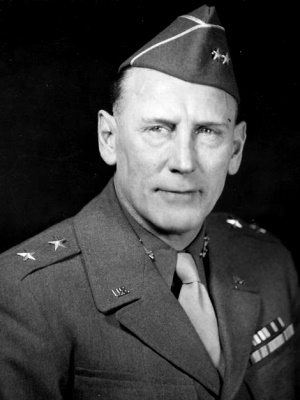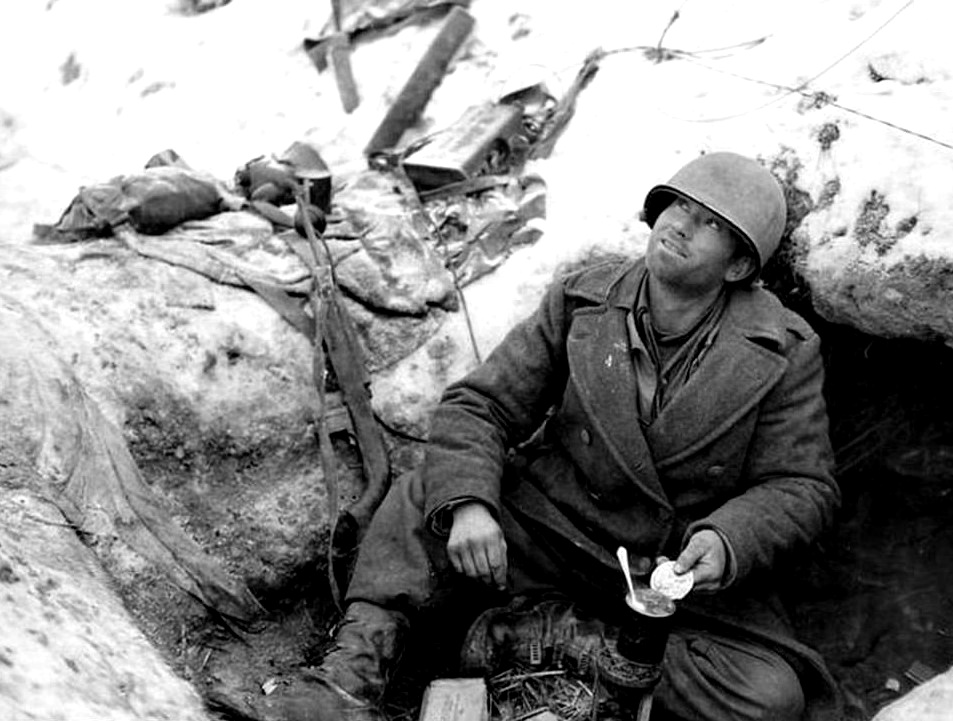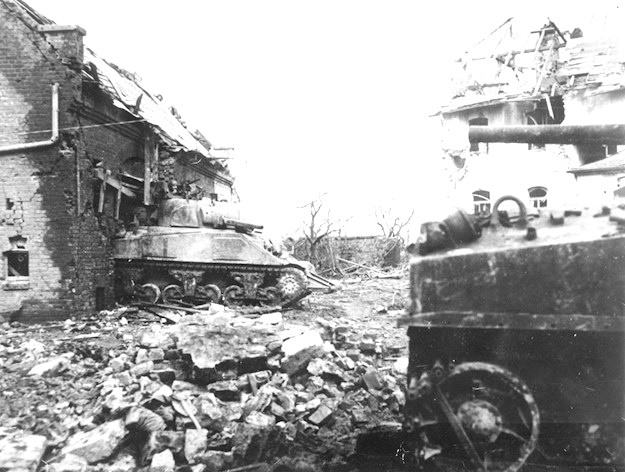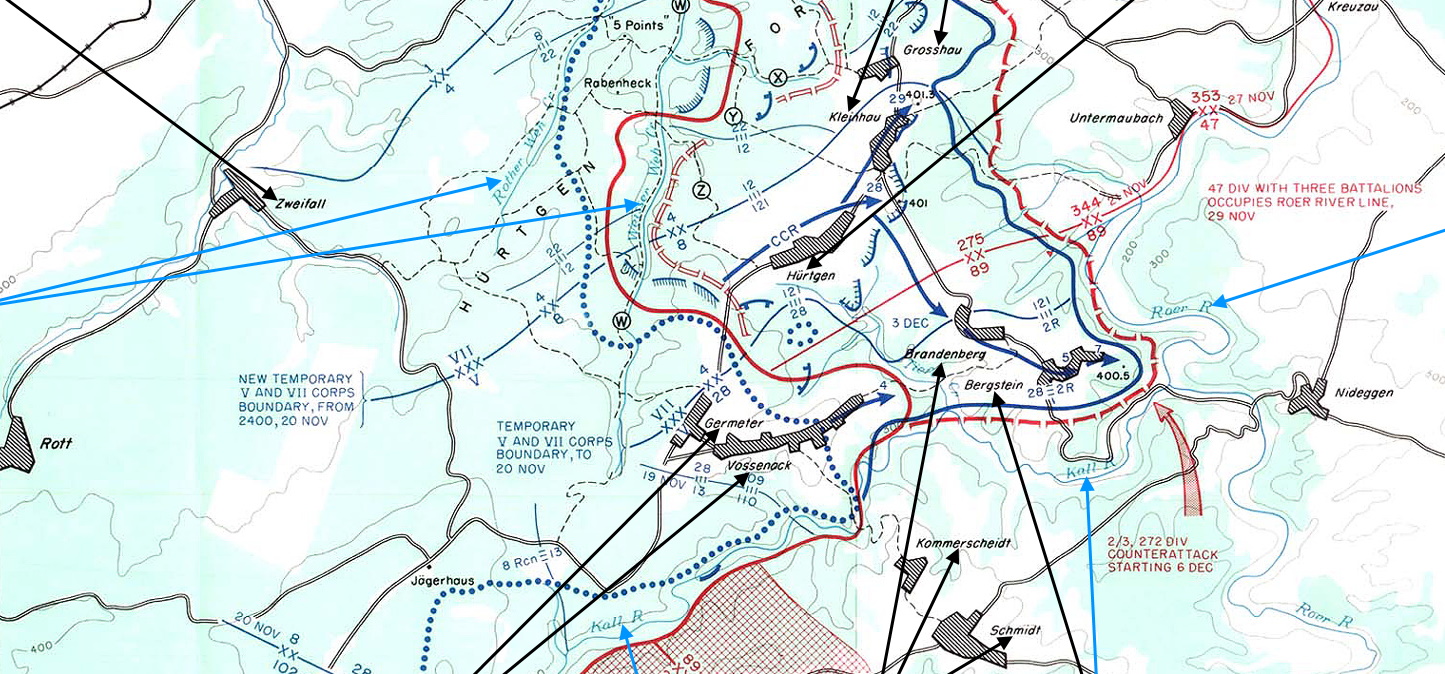
 The 8-ID (including its attached units and ad hoc task forces) had endured over 4000 casualties in this phase of the fighting and with the 1-ID and the 4-ID too depleted to attack further; its drive had stalled short of the town of Hof Hardt, (Ambrose, Citizen Soldiers June 7, 1944 – May 7, 1945, 177) and the 83rd Division was tasked with driving through the remainder of the forest; the 83-ID’s CG, Gen Robert C. Macon, was concerned with quickly taking the towns of Gey (331-IR) and Strass (330-IR) on the edge of the Huertgen before more German reinforcements arrived and clearing the way for the 5-AD to push to the Roer River (Miller, A Dark and Bloody Ground: The Huertgen Forest and the Roer River Dams, 1944-1945, 172). The fighting in this last phase was just as savage as it had been for all the other divisions, and the 83-ID suffered heavy infantry and armor losses, approximately 1600 men until Hitler’s Ardennes Offensive or the Battle of the Bulge began on Dec 16, and the fighting then raged to the south of the Hürtgen Forest; after that, the lines there held until after the Bulge was reduced in Jan 1945, and fighting in the area resumed in Feb over the still-contested parts of the Aachen-Hürtgen area (David Colley, Horror in the Huertgen Forest, VFW Magazine, (Nov 1994), 15) which had essentially been absorbed into the post-Bulge campaigns. The WW-1-style stalemate in the Hürtgen Forest involved around 200.000 men and chewed up several American and German divisions, producing almost 60.000 total casualties – but for what?
The 8-ID (including its attached units and ad hoc task forces) had endured over 4000 casualties in this phase of the fighting and with the 1-ID and the 4-ID too depleted to attack further; its drive had stalled short of the town of Hof Hardt, (Ambrose, Citizen Soldiers June 7, 1944 – May 7, 1945, 177) and the 83rd Division was tasked with driving through the remainder of the forest; the 83-ID’s CG, Gen Robert C. Macon, was concerned with quickly taking the towns of Gey (331-IR) and Strass (330-IR) on the edge of the Huertgen before more German reinforcements arrived and clearing the way for the 5-AD to push to the Roer River (Miller, A Dark and Bloody Ground: The Huertgen Forest and the Roer River Dams, 1944-1945, 172). The fighting in this last phase was just as savage as it had been for all the other divisions, and the 83-ID suffered heavy infantry and armor losses, approximately 1600 men until Hitler’s Ardennes Offensive or the Battle of the Bulge began on Dec 16, and the fighting then raged to the south of the Hürtgen Forest; after that, the lines there held until after the Bulge was reduced in Jan 1945, and fighting in the area resumed in Feb over the still-contested parts of the Aachen-Hürtgen area (David Colley, Horror in the Huertgen Forest, VFW Magazine, (Nov 1994), 15) which had essentially been absorbed into the post-Bulge campaigns. The WW-1-style stalemate in the Hürtgen Forest involved around 200.000 men and chewed up several American and German divisions, producing almost 60.000 total casualties – but for what?
The US Army had traded personnel, a lot of them, for roughly fifty square miles of wild forest that proved to be of little value in future operations – and it still could not go any further because it did not control the Roer River dams. It did, however, tie-down and eventually destroy German troops and equipment that could have been used in the Ardennes Offensive – conversely, those same German troops tied down and delayed a much larger American force and allowed the secret buildup that became the Ardennes Offensive – and after all, was said and done, they still retained the Roer dams and the power to flood the valley and either delay the Americans before they crossed the Roer, or destroy them in the valley (Margry, The Battle of the Huertgen Forest, 34).
So, how did this happen? How did the architects of the successful Normandy invasion engineer such a similarly unsuccessful campaign that even mystified their enemies, and what caused it to bog down and become labeled by some historians as a misconceived and fruitless battle (Charles B. MacDonald, The Battle of the Huertgen Forest, 205) and grossly, even criminally stupid? Several factors contributed to the grinding battle of attrition that became the Battle of the Hürtgen Forest, but the genesis of this campaign’s misdirected plan arose with the success of the Normandy invasion; as Allied armies pursued the exhausted and disorganized Germans across France, their leaders saw what they wanted to see, and optimism often overrode practicality. Instead of focusing on annihilating the German Army while it was stunned in France, the first post-Normandy plans centered on capturing territory, allowing the Germans to slip eastward (Ambrose, Citizen Soldiers June 7, 1944 – May 7, 1945, 167), all the while underestimating their ability to counter-attack (Duke, A Catastrophic Battlefield, 745) and affecting future Allied attack plans. The Germans began to regroup, re-arm, and prepare for the defense of their homes and families, while the overconfident Allies experienced logistical difficulties as they marched across France – they were outrunning their supplies, and faced with an overarching planning dilemma – do they pursue now with less-than-ideal numbers and equipment, or hold up, re-arm, and face a rejuvenated enemy who had done the same? (Neillands, The Battle for the Rhine, The Battle of the Bulge and the Ardennes Campaign, 1944, 31)
Montgomery favored a strong push from the north, Patton the same from the south, but ultimately the final decision rested with Eisenhower – and he favored a wide advance, his broad front plan, which he felt allowed for a safe rear area for supply and logistics operation for the push into Germany (Ballard, Rhineland: The US Army Campaigns of World War II, 6), as well as exploiting perceived German weakness, preventing them from massing in response to any strong Allied approach ( G.E. Patrick Murray, Eisenhower as Ground-Forces Commander: The British Viewpoint, Transactions of the American Philosophical Society (2007), 158).
It was the opposite of the military principle of concentration of force and in this case, Eisenhower believed that stretching his forces would cause the Germans to stretch theirs (Neillands, The Battle for the Rhine, The Battle of the Bulge and the Ardennes Campaign, 1944, 62, 47, 177). Unfortunately, the Allies lacked the required overwhelming superiority of numbers to make it work, especially when assaulting force multipliers such as the Siegfried Line or the Hürtgen Forest. As historian Robin Neillands asserts in his criticism of the broad front, just telling every commander to push ahead hardly amounts to a strategy (Neillands, The Battle for the Rhine, The Battle of the Bulge and the Ardennes Campaign, 1944, 62, 47, 177), and that same vague idea would exhibit itself later in the campaign, in smaller ways – especially in the Hürtgen Forest, when the elements of Omar N. Bradley’s 12-AG (1-A, 3-A, and 9-A) themselves split into several broad fronts along divisional and regimental lines, resembling at any one time an up to a half-dozen parallel advances too weak to assist one another in any significant way, and lacking the depth to force and then exploit any breaches achieved (Neillands, The Battle for the Rhine, The Battle of the Bulge and the Ardennes Campaign, 1944, 62, 47, 177).
A dozen years after the war, Montgomery, in his memoirs, called the broad front plan uncoordinated and lacking in that it allowed army groups to act with too much independence ( Murray, Eisenhower as Ground-Forces Commander: The British Viewpoint, 158). This was borne out over and over later in the campaign when exhausted units made gains only to withdraw (or be destroyed) because they were too weak to hold, and reinforcements were also too weak or nonexistent. Additionally, within the broad front lay the issue of materiel to funnel into the hoped-for logistics system – Antwerp was still in German hands, and supplies had to go through France, whose infrastructure was destroyed by Allied bombing to allow the Normandy invasion in the first place. The Allies had deprived the Germans in France of roads and railways, but they inherited the fruits of their labors when they recaptured France and were limited in their ability to move while remaining well supplied; the safe area existed, but gasoline shortages meant that much of the needed materiel was trapped in Normandy, awaiting transport to the American units assembling near the Siegfried Line.
The American buildup at the Siegfried Line was nearly simultaneous with the German buildup within it; some American units found the line unoccupied on initial probes, only to meet fierce resistance upon their return a few days later. Despite the commonly held American belief that the German army was finished and no longer posed a serious threat, it was still a potent force, and far from finished. FM Walter Model was given command of Army Group B and ordered by Hitler to reinforce the Westwall; described as a ruthless, coarse bully who resorted to threats and ultimatums to inspire his subordinates, Model was also a highly-regarded defensive specialist who, in his new role, was encouraged to make the most of his talents. His quick rebuilding of the German army was referred to as the Miracle of the West (Miller, A Dark and Bloody Ground: The Huertgen Forest and the Roer River Dams, 1944-1945, 7-9, 207). In matters of technology, the resurgent German army was bolstered by the production surges of 1944 – hundreds of medium and heavy tanks were produced and ready to fight in the west, airplane production resumed at a high rate, and research continued on Hitler’s wonder weapons. It was widely accepted that German tanks, with their heavier armor and better guns, were superior to their American counterparts, but their superiority was offset by their numbers – fewer German tanks were available to combat the larger numbers of Shermans and tank destroyers. Ironically, the American tank destroyers possessed greater speed and the larger guns needed to penetrate German armor, but their thinner armor made their crews reluctant to engage German tanks without tank support (Miller, A Dark and Bloody Ground: The Huertgen Forest and the Roer River Dams, 1944-1945, 7-9, 207).
The Shermans, however, had been adapted to utility tanks, such as flamethrowers and bulldozers (Ferrell, The Battle of Aachen, 32). On the squad level, the standard .30-caliber machine gun had a much slower rate of fire than the German MG-34/42, but the semi-automatic American M-1 Garand was superior to the bolt-action Kar 98, and though the newer Volksturm units were armed with machine pistols (MP-38/40, Neumünster), the Kar 98 was still widely used. Artillery was fairly evenly matched, though doctrine for its use differed, and American fire control and communication were considered superior (Snow, et al. CSI Battle book II-A: Hürtgen Forest, III-12). The new German divisions created by the comb-out of hospitals, rear-echelon, and Luftwaffe units (no longer needed because the Luftwaffe was a shadow of its former operational self), approximately 180.000 men, were combined with surviving units and reformed by the command elements of the German army that remained operational through the flight through France, and reconnaissance took place in the Hürtgen Forest while other units performed delaying actions. Himmler, now commander of the Replacement Army, rushed his (better-armed but smaller) Volksgrenadier Divisions to the Western Front, augmented by regular army training divisions (Rush, A Different Perspective: Cohesion, Morale, and Operational Effectiveness in the German Army, Fall 1944”, 480).
The abandonment of the Westwall after the fall of France turned out to be a blessing, and years of neglect allowed the forest to take over, naturally camouflaging it; the German units mashed together in the reorganization fixed, rearmed, and manned existing bunkers and fortified the line with mines, wire barriers, trenches, and traps (Margry, The Battle of the Huertgen Forest, 34), and prepared for active defense.
The forest was more important to the Germans than the Americans, for several reasons; for one, it was an excellent place to delay and wear down the invading Americans by committing minimal forces, while protecting the rear for both a general troop build-up and Hitler’s planned counter-attack through the Ardennes (Miller, A Dark and Bloody Ground: The Huertgen Forest and the Roer River Dams, 1944-1945, 5). German leaders also knew the importance of the Roer River and its dams, and had to protect them – the Roer plain could, as a last resort, be flooded with the dams’ opening or destruction and delay the American advance to the Rhine River, so they had to be retained – and the most direct route to the major dams (Schwammenauel and Urft) lay through the Hürtgen Forest. The German plan to protect the dams, and the river, differed greatly from that of the Americans.
Both, Gen Hodges’ 1-A and Gen Collin’s VII Corps were veterans of WWI’s Meuse-Argonne fighting, and were wary of being outflanked by the enemy from any direction; the Hürtgen Forest represented a possible staging area from which the Germans could launch a flanking attack from the south against the 1-A’s advance on Aachen, and they felt that the forest could be taken with minimal effort, as intelligence indicated that the forest was populated by under-strength German units loosely controlled and with very low morale (Charles B. MacDonald, The Battle of the Huertgen Forest, 60-61). The plans that followed were heavily based on the assumption that they were, in fact, ready to vacate the forest and the Westwall in the same manner they left France (Neillands, The Battle for the Rhine, The Battle of the Bulge and the Ardennes Campaign, 1944, 239-240). With a show of superior American forces, the Germans were expected to just leave, leaving open the way to the Roer River, the Rhine, and Germany itself. The warning provided by the 60-ID’s first hard-fought incursion in the forest went unheeded, and so possession of the forest and its towns and roads became the initial target of this campaign – and the US Army committed itself to the forest.























